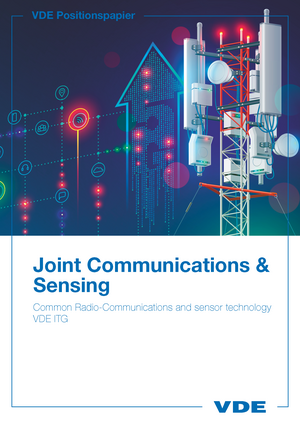1G, 2G, 3G, 4G, 5G. And now?
Publication of the new VDE position paper: Joint Communication & Sensing.

When the first public, nationwide mobile communications network was established 63 years ago, connections between subscribers were still being made by hand. Some thirty years later, digital mobile communications conquered the world and made mobile telephony suitable for the masses. At the turn of the millennium, almost one in two people already had their own mobile device: thanks to broadband technology, video conferencing, digital TV and Internet use were possible in the private sphere. LTE technology in the 2010s increases speed and performance many times over. Not too late, the introduction of the smartphone is causing an explosion in user numbers and demands for data volume and speed. Increasing demands for overall connectivity, the desire for more complex IoT solutions and smart devices that require data transmission at real-time speeds are finally paving the way for 5G.
In order for autonomous devices and robots to find their way in wide-area environments, analyze their environment to a sufficient degree, and react in fractions of a second, the necessary sensor technology for localization and spectroscopy as well as their secure and trustworthy processing are needed in addition to improved real-time transmission. This task should and can be met by 6G as the latest generation of mobile communications. Probably the most promising technology for implementation lies in the cooperation of radio communication and radio sensor technology.
"Whether it's Car2Car communication and traffic safety in the automotive industry or the precise localization of unmanned transport units in logistics, we need an efficient, reliable solution, and Joint Communication & Sensing (JC & S) provides it," explains Prof. Dr. Hans Dieter Schotten, member of the Executive Committee of the German Electrical and Electronic Manufacturers' Association (VDE) and Scientific Director of the Intelligent Networks research area at the German Research Center for Artificial Intelligence (DFKI).
In the future, networked robots will exchange their radar information to make the sensing of their surroundings more reliable and accurate. The radio waves used for this communication will simultaneously be used for environment detection to eliminate the need for separate radars while conserving resources. "If we insert a minimal pause when a radio signal is transmitted from A to B, a radar image can be created via the resulting echo. This is only possible with 6G, although initial realizations show that the approach works," explains Prof. Dr.-Ing. Dr. h.c. Gerhard Fettweis, spokesman of the VDE/ITG focus group on mobile communications, managing director of the Barkhausen Institute and professor of mobile communications systems at the Technical University of Dresden.
In the VDE position paper "Joint Communications & Sensing Common Radio-Communications and sensor technology" the experts highlight the potential and social significance of this technology of the future. In addition to the requirements for the technology, there are also concrete application scenarios. These are not only in the area of driving or flight safety and Industry 4.0, but also in the medical context in the form of nursing robots and machine orthoses or household assistants in the private sector. "In particular, strong sectors such as the German consumer goods industry or medical technology will receive a pulse of innovation from JC & S and remain successful internationally," predicts Prof. Dr. Fettweis.
The paper clarifies in detail the challenges that JC & S poses to science, business and also society. At the same time, it provides concrete recommendations for action on how Germany can take the step toward a leading position in 6G with the help of Joint Communication & Sensing.
You can download the complete position paper here on the VDE website.
